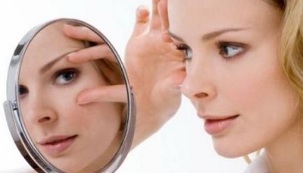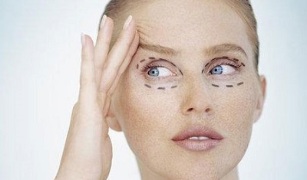
Blepharoplasty in modern makeup is a necessary operation, with the help of which you can change the shape of the eyelids, cut the eyes, tighten the eyelids and remove many cosmetic blemishes on this facial area.
This procedure involves the removal of excess fat and eyelid skin. Especially popular is transconjunctival transphonoplasty, which allows you to get rid of fatty hernias with minimal loss, that is, without affecting the skin.
Reading
Like other cosmetic procedures, eyelid blepharoplasty has a number of indications:
- hanging eyelid skin (top and bottom);
- "fat bag" in the eye area;
- "aging" eyelids;
- ptosis (ptosis) of the lower corner of the eye, as a result of which the shape changes: the incision is significantly reduced;
- "Heavy" eyelids (looks tired)
Age-related changes put the time stamp on the eyelids earlier, as the skin around the eyes is very sensitive and soft. After 30 years, many people think of eyelid blepharoplasty as the only safety from sagging and fat storage in this area. One does not dare to take this step because of ignorance and fear. And that’s useless: the procedure is safe, effective, and when carried out properly, has a minimum of negative consequences. You just have to get to know him better. True, there are several types of blepharoplasty, each with its own characteristics.
Display
In modern cosmetology, different types of blepharoplasty are distinguished.
1. Correction of upper eyelids
For many people, blepharoplasty on the upper eyelid becomes a real safety, the main purpose is to eliminate overhanging. The operation is performed through a skin incision along the folds of the upper eyelid. It removes excess skin. At the patient's request, they can immediately perform plastic surgery on the muscle, removing excess fat.
2. Correction of lower eyelids
The most popular type is blepharoplasty on the lower eyelid, which relieves edema, hernias, bags under the eyes. The almost invisible stitches run along the edges of the lashes. This operation is called transcutaneous or subcliliary blepharoplasty by a doctor. If the doctor chooses a transconjunctival procedure, an incision is made on the inside of the eyelid. This may happen if you need to redistribute or remove fatty tissue around the eyes, and no skin cover removal is required. This type of blepharoplasty is most often used by young patients.
3. Blepharoplasty round
Round blepharoplasty involves simultaneous correction of the lower and upper eyelids.
4. Blepharoplasty laser

Many cosmetology clinics today offer an excellent alternative to surgical eyelid removal, namely laser blepharoplasty on a variety of devices. It requires no cuts or stitches. Doctors control the depth of laser penetration and the degree of warming of the epidermis. As a result, tissue damage and recovery is minimized. This technology safely and effectively stimulates the production of new collagen and elastin, thus achieving a lifting effect. This procedure takes about 30 minutes, is easy to accept, does not require anesthesia, and does not cause the formation of hematomas. Only non-surgical blepharoplasty can provide minimal side effects.
In addition, professional cosmetologists can offer Asian eye shape correction to create Caucasian folds. You can do plastic surgery to remove the exophthalmos (bulging eye effect), cantopexy (lifting the lower eyelid to remove the sad eye expression). The question of how safe drastic measures to rejuvenate the eyelids, is interesting for all women who need blepharoplasty: complications may occur after almost all cosmetic procedures.
Complications
Side effects after the procedure depend mainly on the type of eyelid surgery chosen: complications can be performed early (indicated immediately after surgery) and late.
Early complications
- Prolonged edema of the face for more than a week after blepharoplasty: they may be accompanied by blurred vision, headache.
- Bleeding as a result of a small-sized subcutaneous hematoma (blood flowing out of a damaged vessel accumulated under the epidermis), which is removed by puncture or suture of the vessel. In this case, scars, seals, subcutaneous nodules may remain.
- Bleeding can occur as a result of a hematoma when a large vessel is damaged, when there is an accumulation of blood behind the eyeball. These complications are accompanied by pain, swelling of the eyeballs, limited movement of the eyelids. Threatening glaucoma or temporary loss of vision.
- Conversion of the lower eyelid into, excessive "opening" of the eye, until dry. In this case, special exercises are prescribed, massage to train the round muscles of the eyes. Support sutures are sometimes used, and surgery may be performed.
- Infections that require antibiotic therapy.
Complications through
- Stitching irregularities will cause re-stitching.
- Cysts form, which sometimes disappear on their own, if not removed by a specialist.
- Lachrymation due to narrowing of the lacrimal duct.
- Unpleasant "hot" eye sensation.
- Dry keratoconjunctivitis (inflammation equivalent to the conjunctiva and cornea).
- Blepharoptosis (drooping upper eyelid).
All complications of eyelid blepharoplasty listed require additional therapy and repeated physician intervention. However, because of this, you should not abandon useful and important operations that restore youth. Blepharoplasty can effectively and in a short time solve the most painful problems: it removes fatty tissue and excess skin around the eyes, reduces the manifestations of age-related changes, performs plastic surgery on the muscles of this part of the face, changes the shape and shape of the eyes, removes bladder defectsacquired and congenital points. With such a hint, it is a sin not to take advantage of the unique opportunity to give young and fresh eyes.





















